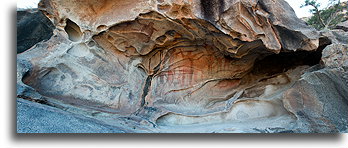The indigenous inhabitants of the central part of the Baja California peninsula in Mexico were the Cochimi Indians. They were hunter-gatherers. Agriculture was unknown to them; they did not use metal. The harsh environment of the region in which they lived imposed a simple lifestyle and culture on them.

The Cochimi had only sporadic contacts with Europeans until 1683, when the Jesuits established the first mission in the peninsula. Over the course of about 100 years, as the number of Jesuit missions increased, the Indian population decreased until finally, the Cochimi ceased to exist.



Only the rock art of the Cochimi Indians has survived. The pinturas or paintings of Mesa del Carmen are in excellent condition and depict various figures. We found two shamans with distinctive head covers, several women and men. The smaller three human figures probably represent children. There is also a deer, two bighorns and fish. This site had so called over-painting; one figure was painted on top of another. It is difficult to say how old this art is. The paintings look authentic, but not very old and without noticeable surface degradation. This may suggest that the paintings may be only a few hundred years old. However, archaeologists say that they fade very slowly. This means that they may be much older, even several thousand years ago.

The rock art of the Sierra de San Francisco is on the UNESCO World Heritage List, but we were not impressed. The rock paintings are covered with dust and in most cases are difficult to recognize. These must be the consequences of the close proximity of a dirt road. In addition, forced to walk on wooden platforms with handrails, we felt like on a school trip. Our guide was not very helpful either. He took the money but said nothing about Indian art.







